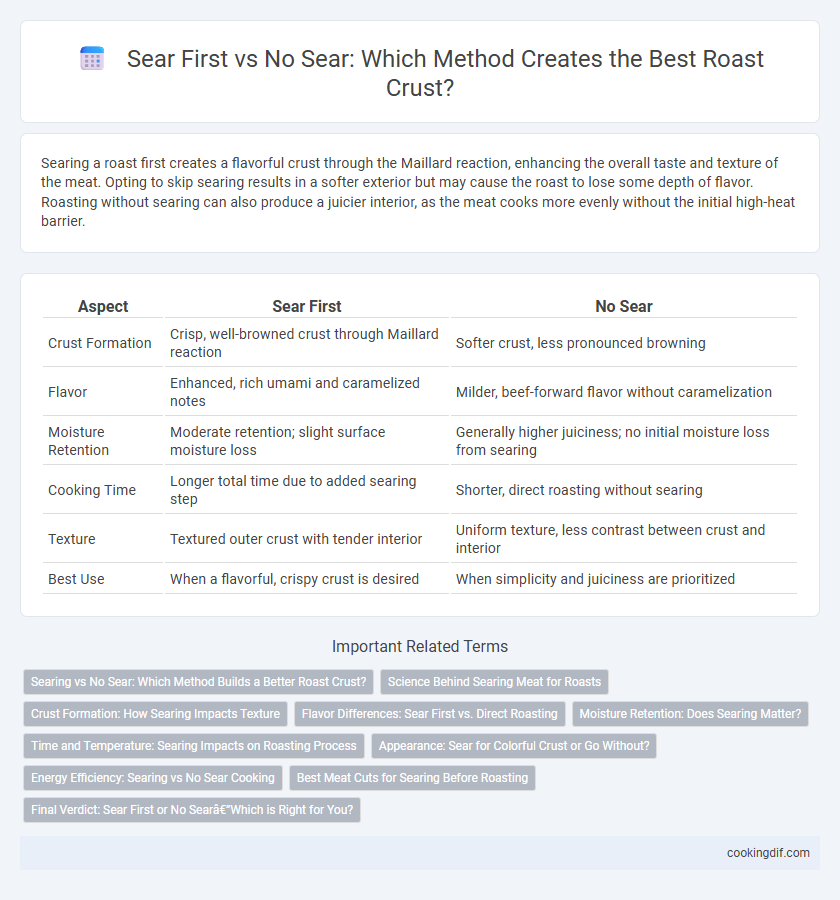Searing a roast first creates a flavorful crust through the Maillard reaction, enhancing the overall taste and texture of the meat. Opting to skip searing results in a softer exterior but may cause the roast to lose some depth of flavor. Roasting without searing can also produce a juicier interior, as the meat cooks more evenly without the initial high-heat barrier.
Table of Comparison
| Aspect | Sear First | No Sear |
|---|---|---|
| Crust Formation | Crisp, well-browned crust through Maillard reaction | Softer crust, less pronounced browning |
| Flavor | Enhanced, rich umami and caramelized notes | Milder, beef-forward flavor without caramelization |
| Moisture Retention | Moderate retention; slight surface moisture loss | Generally higher juiciness; no initial moisture loss from searing |
| Cooking Time | Longer total time due to added searing step | Shorter, direct roasting without searing |
| Texture | Textured outer crust with tender interior | Uniform texture, less contrast between crust and interior |
| Best Use | When a flavorful, crispy crust is desired | When simplicity and juiciness are prioritized |
Searing vs No Sear: Which Method Builds a Better Roast Crust?
Searing a roast forms a Maillard crust by caramelizing the surface proteins and sugars at high heat, which enhances flavor and texture through complex chemical reactions. In contrast, skipping searing produces a less pronounced crust but preserves more internal moisture and tenderness. Studies show searing locks in flavor compounds while no sear maintains juiciness, making searing preferable for a robust crust without compromising roast quality.
Science Behind Searing Meat for Roasts
Searing meat for roasts initiates the Maillard reaction, creating a flavorful crust through the interaction of amino acids and reducing sugars at high temperatures. Contrary to popular belief, searing does not seal in juices but enhances flavor complexity and texture by developing caramelized compounds. Skipping the sear may result in a less aromatic crust and a milder taste profile, as the Maillard reaction contributes significantly to the roast's sensory attributes.
Crust Formation: How Searing Impacts Texture
Searing a roast initiates the Maillard reaction, producing a rich, flavorful crust with a distinct texture compared to no-sear methods. The intense heat causes proteins and sugars on the surface to brown, creating a crispy, caramelized exterior that enhances mouthfeel. Without searing, the roast develops a softer crust, lacking the complex flavor profile and textural contrast that searing provides.
Flavor Differences: Sear First vs. Direct Roasting
Searing a roast first develops a rich, caramelized crust through the Maillard reaction, intensifying flavor complexity and creating savory, nutty notes that enhance the overall taste. Direct roasting without searing produces a milder crust, relying on oven heat to slowly brown the exterior, resulting in a less pronounced but tender flavor profile. The choice affects the roast's texture and depth, with searing delivering a more robust, aromatic experience compared to the subtler, juicier character of no-sear roasts.
Moisture Retention: Does Searing Matter?
Searing a roast before cooking creates a caramelized crust that can enhance flavor but does not significantly improve moisture retention, as the Maillard reaction occurs on the surface without sealing in juices. Studies show that skipping the searing step does not result in a drier roast, since moisture loss during roasting primarily depends on cooking temperature and time. Proper roasting techniques, such as using a probe thermometer and resting the meat, are more critical factors for preserving roast juiciness than whether the meat is seared first.
Time and Temperature: Searing Impacts on Roasting Process
Searing a roast at high temperature before cooking creates a flavorful crust and helps lock in juices, reducing overall roasting time by initiating the Maillard reaction early. Roasting without searing requires longer cooking at a consistent temperature to develop browning, which can result in less depth of flavor and a softer crust. Adjusting time and temperature based on searing decisions optimizes texture and flavor while ensuring even doneness.
Appearance: Sear for Colorful Crust or Go Without?
Searing a roast before cooking intensifies the crust's color by triggering the Maillard reaction, producing a rich, caramelized exterior that enhances visual appeal. Skipping the sear often results in a paler, less textured crust, which can appear less appetizing despite retaining moisture. For a vibrant, golden-brown roast crust, searing remains the preferred technique to achieve an appealing presentation.
Energy Efficiency: Searing vs No Sear Cooking
Searing a roast creates a flavorful crust by inducing the Maillard reaction, but it requires higher initial energy input due to elevated pan temperatures. Cooking a roast without searing reduces immediate energy consumption, as it omits the high-heat step, potentially improving overall energy efficiency during slow roasting. However, the lack of sear may extend cooking time and impact moisture retention, influencing the total energy expenditure throughout the cooking process.
Best Meat Cuts for Searing Before Roasting
Searing before roasting locks in juices and enhances the crust with a Maillard reaction, ideal for tender cuts like ribeye, strip loin, and sirloin. Tougher cuts such as chuck or brisket benefit less from searing but gain from slow roasting to break down connective tissue. Choosing prime cuts for searing ensures a flavorful crust while preserving the meat's tenderness and succulence during roasting.
Final Verdict: Sear First or No Sear—Which is Right for You?
Searing a roast first creates a flavorful crust through the Maillard reaction, enhancing taste and texture by locking in juices and adding depth to the exterior. Skipping the sear allows for more even cooking and maintains a juicier interior but may result in a less complex crust flavor. Choosing to sear depends on the desired balance between crust intensity and internal moisture retention in your roast.
Sear first vs No sear for roast crust Infographic

 cookingdif.com
cookingdif.com